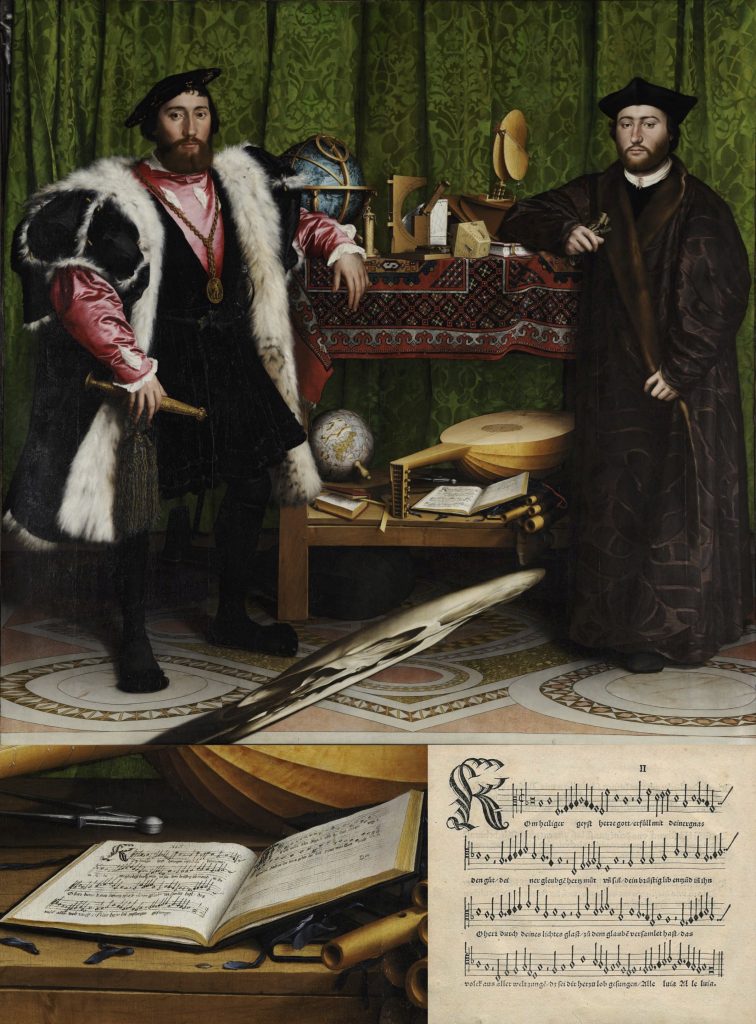
Hans Holbein the Younger was born in Augsburg, Germany in the late 15th century. He was a painter and ended up doing a great deal of his work in England, gaining Thomas Cromwell and Anne Boleyn as patrons in 1532. This was the same year that King Henry VIII secretly married Anne, while Cromwell pushed for the religious reform necessary to get the king’s marriage to Catherine annulled. In early 1533, King Henry VIII publicly married Anne, and in May, Thomas Cranmer, the new Archbishop of Canterbury, declared the annulment that the king had long sought.
That same year, 1533, saw the arrival of two French ambassadors to England: Jean de Dinteville, a diplomat, and Georges de Selve, the Bishop of Lavaur. Whether or not their business concerned the recent tumultuous events in England, we do not know. What we do know is that one of these ambassadors commissioned Holbein to paint a portrait of the pair.
The work is stunning. The fabrics in the scene are exquisite. There’s an amazing anamorphic skull (look at that gray streak at an angle). The shelves between the two men feature instruments of astronomy, a math book, and a lute, all the items together evoking the liberal arts of the quadrivium: arithmetic, geometry, music, and astronomy. And beneath the lute sits another book, and that book is the reason this painting appears in Christian Culture. That book is the Geystliche gesangk Buchleyn, A Little Book of Spiritual Songs.
This is remarkable: In 1533, in England, in between two French ambassadors, one of whom is a Roman Catholic bishop, sits the first Lutheran hymnal, the Geystliche gesangk Buchleyn, published in 1524, edited by Johann Walter with a foreword by Martin Luther. The left page features Luther’s Pentecost hymn, Komm Heiliger Geist, which is “Come, Holy Ghost, God and Lord” (LSB 497). The right page features another of Luther’s hymns, Mensch, Willt Du Leben Seliglich, “Man, Do You Want to Live Happily,” a hymn that briefly treats the Ten Commandments.
Sixteen years after Luther posted the 95 Theses, three years after the presentation of the Augsburg Confession, this little Lutheran hymn book was making its way around Europe. Now, in the twenty-first century, Jean de Dinteville and Georges de Selve have ceased to matter. They’re almost exclusively known for appearing in this painting. As for Henry VIII, Anne Boleyn, Cromwell, and Cranmer, their history is interesting, but the fact remains that religious reform in England was marred by a man’s passion for divorce (let’s call it what it was) and not primarily driven by a love of the truth of God’s Word. But this little hymn book, tucked on a bottom shelf between two wealthy and respected men whom nobody remembers—this little hymn book changed the world, and the Church continues to sing hymns from it to this day.
Come, Holy Spirit, God and Lord,
With all Your good grace
Fill the heart and mind of Your believers,
Kindle Your burning love in them.
O Lord, through the brightness of Your light,
You have gathered the people
From all the world’s tongues.
This to Your praise, O Lord our God be sung.
Halleluia! Halleluia!
The hymns of this book persist because they spring from the conviction of faith that holds tenaciously to the Word of God. Diplomats and ambassadors will come and go, but a good hymn will last as long as this world does, and then enjoy its eternal abode on the lips of the saints in paradise.
A.R., with thanks to M.P. for German translations.
We became aware of this painting through Carl Schalk’s book Music in Early Lutheranism: Shaping the Tradition (St. Louis: Concordia Academic Press, 2001)



